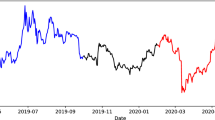Abstract
This paper aims to develop a new free stochastic volatility model, joint with jumps. By freeing the power parameter of instantaneous variance, this paper takes Heston model and 3/2 model for special examples, and extends the generalizability. This model is named after free stochastic volatility model, and it owns two distinctive features. First of all, the power parameter is not constrained, so as to enable the data to voice its authentic direction. The Generalized Methods of Moments suggest that the purpose of this newly-added parameter is to create various volatility fluctuations observed in financial market. Secondly, even upward and downward jumps are separately modeled to accommodate the market data, this paper still provides the quasi-closed-form solutions for futures and option prices. Consequently, the model is novel and highly tractable. Here, it should be noted that the data on VIX futures and corresponding option contracts is employed to evaluate the model, in terms of its pricing and implied volatility features capturing performance. To sum up, the free stochastic volatility model with asymmetric jumps is capable of adequately capturing the implied volatility dynamics. Thus, it can be regarded as a model advantageous in pricing VIX derivatives with fixed power volatility models.





Similar content being viewed by others
References
Bates, D. S. (2000). Post-’87 crash fears in the S&P 500 futures option market. Journal of Econometrics, 94(1–2), 181–238.
Baldeaux, J., & Badran, A. (2014). Consistent modelling of VIX and equity derivatives using a 3/2 plus jumps model. Applied Mathematical Finance, 21(4), 299–312.
Bluman, G., & Kumei, S. (1989). Symmetries and differential equations. Applied Mathematical Sciences, Vol. 81. New York: Springer.
Breeden, D. T., & Litzenberger, R. H. (1978). Prices of state-contingent claims implicit in option prices. Journal of Business, 51(4), 621–651.
CBOE. (2003). VIX: CBOE volatility index. Available at www.cboe.com/micro/vix/vixwhite.pdf.
Chan, K. C., Karolyi, G. A., Longstaff, F. A., & Sanders, A. B. (1992). An empirical comparison of alternative models of the short-term interest rate. The Journal of Finance, 47(3), 1209–1227.
Craddock, M., & Lennox, K. A. (2009). The calculation of expectations for classes of diffusion processes by Lie symmetry methods. The Annals of Applied Probability, 19(1), 127–157.
Drimus, G. G. (2012). Options on realized variance by transform methods: A non-affine stochastic volatility model. Quantitative Finance, 12(11), 1679–1694.
Duan, J. C., & Yeh, C. Y. (2010). Jump and volatility risk premiums implied by VIX. Journal of Economic Dynamics and Control, 34(11), 2232–2244.
Goard, J., & Mazur, M. (2013). Stochastic volatility models and the pricing of VIX options. Mathematical Finance, 23(3), 439–458.
Grasselli, M. (2017). The 4/2 stochastic volatility model: A unified approach for the Heston and the 3/2 model. Mathematical Finance, 27(4), 1013–1034.
Grunbichler, A., & Longstaff, F. A. (1996). Valuing futures and options on volatility. Journal of Banking & Finance, 20(6), 985–1001.
Hansen, L. P. (1982). Large sample properties of generalized method of moments estimators. Econometrica, 50(4), 1029–1054.
Heston, S. L. (1993). A closed-form solution for options with stochastic volatility with applications to bond and currency options. Review of Financial Studies, 6(2), 327–343.
Lewis, A. L. (2000). Option valuation under stochastic volatility. Newport Beach, CA: Finance Press.
Lian, G. H., & Zhu, S. P. (2013). Pricing VIX options with stochastic volatility and random jumps. Decisions in Economics and Finance, 36(1), 71–88.
Lin, W., Li, S. H., Luo, X. G., & Chern, S. (2017). Consistent pricing of VIX and equity derivatives with the 4/2 stochastic volatility plus jumps model. Journal of Mathematical Analysis and Applications, 447(2), 778–797.
Olver, P. J. (1993). Applications of Lie groups to differential equations, 2nd Edn. Graduate Texts in Mathematics, 107. New York: Springer.
Pan, J. (2002). The jump-risk premia implicit in options: evidence from an integrated time-series study. Journal of Financial Economics, 63(1), 3–50.
Park, Y. H. (2016). The Effects of asymmetric volatility and jumps on the pricing of VIX derivatives. Journal of Econometrics, 192(1), 313–328.
Sepp, A. (2008). VIX option pricing in a jump-diffusion model. Risk Magazine, 84–89. https://papers.ssrn.com/sol3/papers.cfm?abstract_id=1412339.
Whitney, K. N. (1985). Generalized method of moment specification testing. Journal of Econometric, 29, 229–256.
Zhang, J. E., & Zhu, Y. (2006). VIX futures. Journal of Futures Markets, 26(6), 521–531.
Acknowledgements
This work is supported by the National Natural Science Foundation of China (No. 11571310A011402) and Jin E. Zhang has been supported by an establishment grant from the University of Otago and the National Natural Science Foundation of China (Project No. 71771199).
Author information
Authors and Affiliations
Corresponding author
Additional information
This work is supported by the National Natural Science Foundation of China (Nos. 11171304 and 71371168) and Zhejiang Provincial Natural Science Foundation of China (No. Y6110023).
Appendix: Derivation of 1st and 2nd order moment of \(\varepsilon _{t+1}\)
Appendix: Derivation of 1st and 2nd order moment of \(\varepsilon _{t+1}\)
To derive \(\mathbb {E}^{\mathbb {Q}}[\varepsilon _{t+1}]\) and \(\mathbb {E}^{\mathbb {Q}}[\varepsilon _{t+1}^{2}]\), we split the Brownian motion \(W^{\mathbb {P}}\) into \(Z^{\mathbb {P}}\) and its orthogonal part \(Z^{\mathbb {P},\bot }\) and obtain
Taking expectation to both sides, it follows that
The second and third terms in the last equation equal 0 due to the independence and independent increments of Brownian motion. On the other hand, the second moment of \(\varepsilon _{t+1}\) is explicitly known as
where we use Remark 2.1 by setting \(\eta \) to be different values and the fact that \(V_t\) is a Markov process.
Rights and permissions
About this article
Cite this article
Lin, W., Li, S., Chern, S. et al. Pricing VIX derivatives with free stochastic volatility model. Rev Deriv Res 22, 41–75 (2019). https://doi.org/10.1007/s11147-018-9145-y
Published:
Issue Date:
DOI: https://doi.org/10.1007/s11147-018-9145-y




